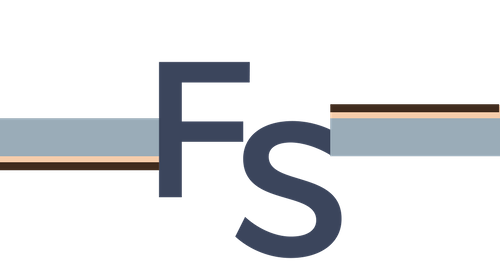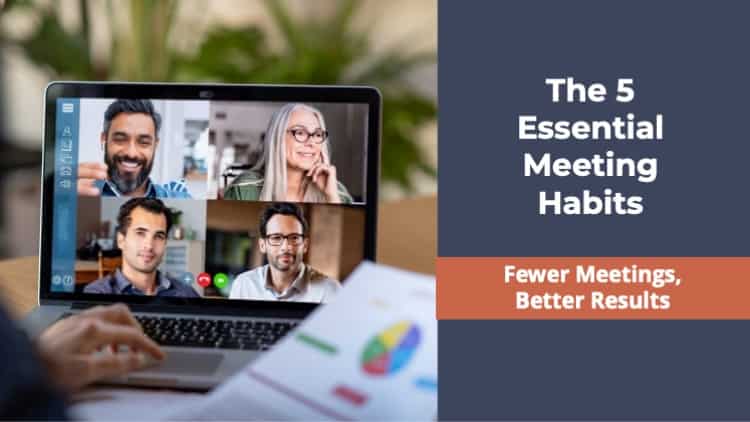In this last part of my three-part series on eliminating the drag that’s holding your business back, we’ll tackle one of the biggest drains of time and energy: ineffective meetings.
In this post, I’ll share with you an overview of the key concepts in my online course, “5 Essential Meeting Habits that Will Transform Your Work.” In this course, I share the habits that will help you make your meetings count and create more capacity and time to do the work that matters most to you.
Bonus: I’ve got a coupon code at the end of the post for 50% off the course if you want to dive more deeply into these habits and truly transform the way you work.
The Pain Is Real
When working in the corporate world for over 20 years, my calendar was out of control, with meetings stacked one after the other. Half of them were unnecessary, too long, or unproductive and the other half seemed to result in more confusion than clarity. It felt like the only time I had to get MY work done was early in the morning, late in the evenings, or on the weekends.
Does that sound familiar?
%
% Time Avg Mgr Spends In Status Meetings
%
% Time Sr. Leaders Spend in Meetings
The average manager spends 33% of the Week in Status and update Meetings. That’s 1/3 of your week getting updated and primarily sharing information. I can’t stress this enough: meetings are inefficient and ineffective places to share information.
For senior leaders, the cost is even higher. According to a Harvard Business Review study, business leaders spend an average of 72 percent of their time in meetings during any given week.
There’s a high soft cost (and I would argue the highest price) of all of this time spent in unproductive meetings, and it’s taking a toll on our well-being.
An international study on the cost of poorly organized meetings showed that people think 71% of the meetings they attend are unproductive and inefficient.
No wonder we are frustrated at work!
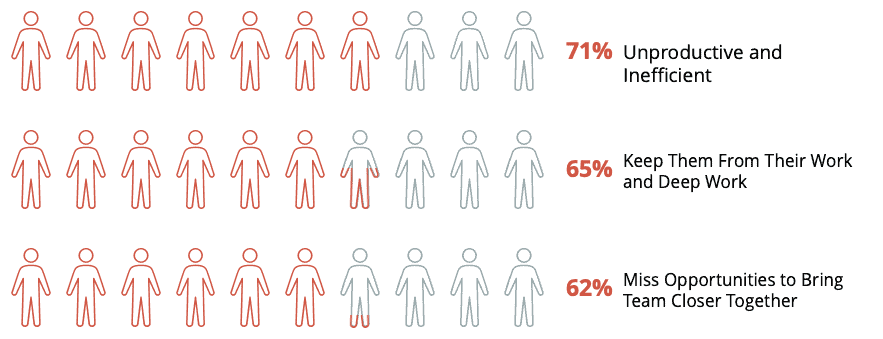
And 65% said these meetings keep them from doing their work and, more importantly, what we call deep work.
That’s the work where you find purpose, inspiration, and a sense of accomplishment, and we can’t work on it because we are sitting in unproductive meetings!
And lastly, something I believe is essential but is often overlooked, 62% of professionals say these meetings miss an opportunity to bring the team closer together. That is a huge miss.
This all sounds pretty bad, but it’s not news to you. The good news is we can learn how to change meetings and our current meeting culture from an energy-draining, time suck to a productive, engaging experience that genuinely drives results.
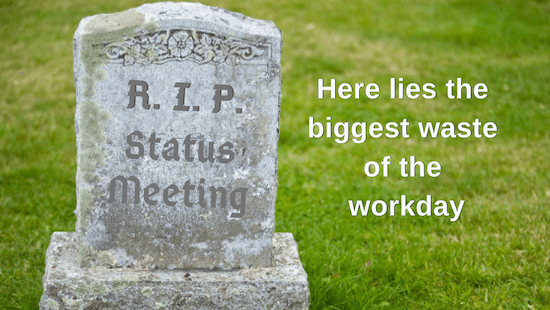
Habit #1: Kill the Status Meeting
The first habit is Kill the Status Meeting, and I put this habit first because it is a gamechanger. If you only implemented one of the five habits (but let’s be clear, I hope you will implement all five), this would be it. Status meetings are where we spend most of our meeting time, and we are dying in them. It sounds dramatic, but it’s pretty much on point. I’ll teach you a much better way to approach status meetings that will transform your work!
Note: This habit is based on this earlier blog post you might want to check out.

Habit #2: Ditch the Agenda
Yes, I can hear jaws dropping. But most meetings are an hour or less, and the fact that we even need an agenda is evidence we are trying to accomplish too much and don’t understand how to focus the attention and energy of a larger group. The best way to maintain focus, promote deep thinking, and achieve meeting goals is to have absolute clarity on the One Thing you want to accomplish. You’ll learn how to define and require this One Thing in each meeting invitation title to improve each meeting’s outcome and participant’s experience.
Note: This habit is based on this earlier blog post.
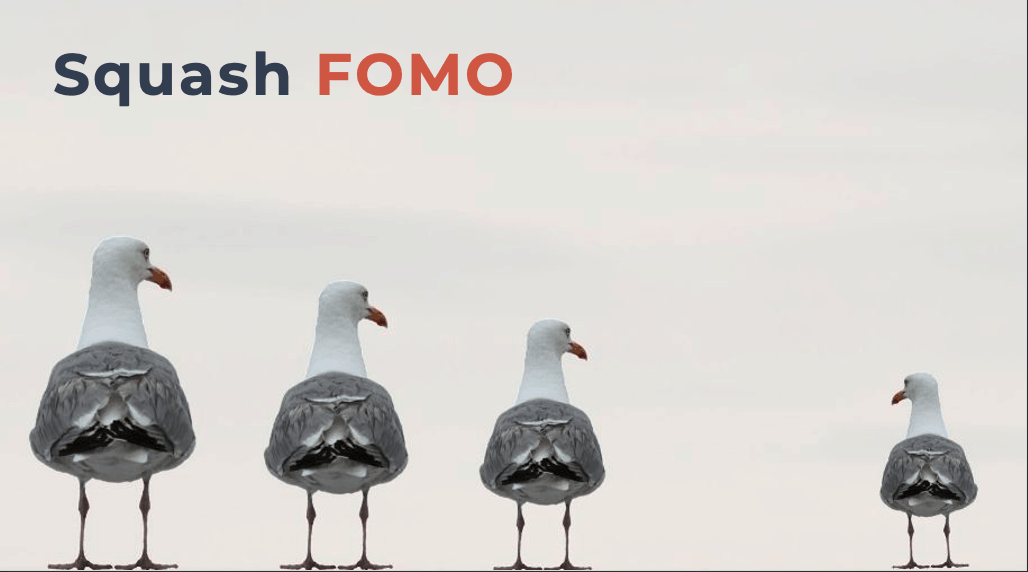
Habit #3: Squash FOMO
Information is currency. FOMO is part of what drives so many big meetings and why we are afraid to decline meeting invitations or send someone else in our place. If people don’t trust that they will get the information they need to do their job or that no one will hear or consider their point of view on an issue, it’s understandable to fear missing out if you’re not in a meeting.
This view perpetuates a meeting culture fueling the number of meetings and the number of people in a meeting. The good news is, there is a better way.
Transparency is the anecdote. In this part of the course, we’ll learn how to create transparency, squash the FOMO, and nurture trust in the organization.

Habit #4: Keep Meetings Small
We all know that smaller meetings are better meetings, but it can be tough to implement. Often meeting size expands because we want to include as many viewpoints as possible, and we don’t want anyone to feel left out. We end up adding people to meetings just in case they may want to add something, or so they feel included. And the meeting size only balloons.
While this is well-intentioned, it doesn’t serve the organization or the meeting participants as big meetings are ineffective for getting work done. But we need to be inclusive and get feedback, and I’ll teach you how to do that without feeling like you have to invite everyone to every meeting.

Habit #5: KonMari Your Calendar
With habit #5, we will learn to apply Marie Kondo’s method (the author of The Life-Changing Magic of Tidying Up) to our calendars. Like an unruly closest, our calendars can become stuffed with meetings that no longer serve us. I’ll show you two techniques that will help you become your fiercest time guardian to create more capacity and reclaim your time.
Note: This habit is based on this earlier blog post.
GET 50% OFF!

In all honesty, it wasn’t until I was out of the corporate world and managing my own business that I truly understood how crazy the corporate meeting culture is. The problem is we’ve become so desensitized to it and have just accepted that this is the way it is.
It doesn’t have to be this way.
We know that one of the biggest drivers in fulfillment at work is making progress on meaningful work, doing the stuff that matters. But we have to create the capacity to do this vital work, and the corporate meeting culture is one of the biggest obstacles holding us back.
I’m thrilled to share the “5 Essential Meeting Habits” course with you to help you make your meetings more meaningful and help you create more capacity and time to do the work that matters most to you.
Let’s get started!

